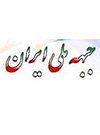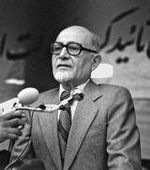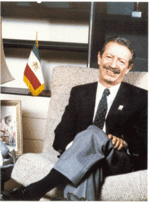- National Front (Iran)
-
National Front of Iran
جبههی ملی ایران
Leader Adib Boroumand Founded 1949 Headquarters Tehran, Iran Ideology Secularism, Nationalism
Liberalism
Social democracy
Iranian nationalismPolitical position Center-left International affiliation None Politics of Iran
Political parties
ElectionsThe National Front of Iran or Jebhe Melli is a Democratic, political opposition group founded by Mohammad Mossadegh and other secular Iranian leaders of Nationalist, Liberal, and Social-Democratic political orientation who had been educated in France in the late 1940s. It held power in the Iranian parliament for several years prior to the 1953 Iranian coup d'état and continued as an opposition force thereafter.
Contents
The Mossadegh Era (1949-1953)
Founded in the late 1940s by Mohammad Mosaddeq, the National Front was a political coalition comprising a broad spectrum of parties and associations. The most important groups in the Front were the Iran Party, the Toilers Party, the National Party, and the Tehran Association of Bazaar Trade and Craft Guilds.[1]
Soon after its founding, the National Front opposed the existing Western domination and control of Iran's natural resources, and related revenues, which began with colonialist concessions given during the Qajar Dynasty. By the mid-1940s, Iran's oil assets were owned by the Anglo-Iranian Oil Company, whose predecessor company bought the concession from William Knox D'Arcy.[2] D'Arcy had negotiated the concession in 1901 with Mozzafar al-Din Shah Qajar, the Shah of Persia, who granted a 60-year petroleum search concession in a transaction in which no money changed hands.[3] For most of the first half of the twentieth century, Iran's oil was the British government's single largest overseas investment; 51 percent of the company was owned by the British government.[4] The AIOC, which later became BP consistently violated the terms of the agreement that had been updated in 1933, and was reluctant to change the terms of the agreement even as Iran's movement for nationalization grew in the late 1940s.[5] Although AIOC was highly profitable, "its Iranian workers were poorly paid and lived in squalid conditions."
The goal of the National Front was to nationalize Iran's oil resources and to counteract British dominance of Iran's internal affairs by initiating direct relations with the United States. The National Front became the governing coalition when it took office in April 1951 with Mossadegh elected Prime Minister. Mossadegh's minister of foreign affairs Hossein Fatemi enforced the "Oil Nationalization Act", passed by the Majlis in March, 1953 and ratified by the Senate. The act, reluctantly signed by the shah, called for nationalization of the assets held by AIOC, from which the government of Iran then only received minimal compensation. This led to British counter-moves and the loss of nearly all income during the Abadan Crisis.
Following Britain's request, U.S. President Dwight D. Eisenhower authorized the Central Intelligence Agency to overthrow the Mossadegh government in an event known as the 1953 Iranian coup d'état. Prior to the coup, the National Front was made up of four main parties; the Iran Party, which was founded in 1946 as a platform for Iranian liberals, including figures such as Karim Sanjabi, Gholam Hossein Sadighi, Ahmad Zirakzadeh and Allahyar Saleh); the Toilers Party of the Iranian Nation (a left-wing party that advocated a non-communist socialist Iran, led by Mozzafar Baghai and Khalil Maleki); and the Mujahedin-e Islam (an Islamic party led by Ayatollah Abol-Ghasem Kashani).[6]
The Second and Third National Front
In the aftermath of the 1953 Iranian coup d'état carried out by the CIA with support from the British spy service, MI6, the National Front was outlawed and its highest-ranking leaders arrested and brought before a military court. The military coup established Mohammad Reza Shah as the supreme ruler of Iran, although nominal power was held by Prime Minister Fazlollah Zahedi (who was paid by the CIA to help overthrow Mossadegh and strengthen the power of the monarchy. In an atmosphere of police repression, several former members of the National Front (mostly low-ranking leaders) established an underground network called the National Resistance Movement. This group included future prime ministers Mehdi Bazargan and Shapour Bakhtiar and its aim was to reestablish democracy by campaigning for free and fair elections. Its activities were largely restricted to peacefully distributing flyers and attempting to regulate the 1954 Majlis elections (which in the end were rigged in favor of the pro-Shah candidates). Under pressure from the state, it fell apart. But in 1960, the Second National Front was formed, which consisted of prominent people such as Karim Sanjabi, Mehdi Bazargan, Allahyar Saleh, Shapour Bakhtiar, Adib Boroumand, Asghar Parsa, Dariush Forouhar, Gholam Hossein Sadighi, Mohammad Ali Khonji and others. Its aim was to return Mohammad Mossadegh to the premiership and to reestablish the constitutional monarchy. Initially, it seemed as if this organization was gaining in strength. However, the group's leaders fell into disagreements over questions such as the organization of the Front, tactics vis-a-vis the Shah's regime and the form of government the National Front should commit itself to. These disputes led to tension between the high-ranking leaders and the student activists and in 1961, Bazargan, Mahmoud Taleghani (a prominent Islamic cleric) and others formed the Freedom Movement of Iran (FMI) which was committed to a democratic state in which the Islamic religion would play a substantial role in state and society (as opposed to the more secular orientation of the National Front).
Another issue arose over the appointment in April 1961 of Dr. Ali Amini to the premiership. It was widely believed that the Shah had chosen Amini under pressure from the Kennedy Administration in the United States and it was partly for this reason that the National Front's leaders persistently refused to collaborate with or lend support to Ali Amini's government. But political turmoil grew worse and in 1962, Amini stepped down from the premiership due to his dispute with the Shah over the former's plans to reduce the military budget. The following year in June 1963, a huge religious uprising occurred in the cities of Tehran, Qum, Mashad, Shiraz and Varamin, which was put down with ruthless force by the Iranian army. The unrest had been sparked by the arrest of Ayatollah Ruhollah Khomeini, a vocal critic of the Shah and his program of land reforms and granting women the right to vote. Around this time, the Third National Front was formed, which consisted of the FMI (religious-nationalists; Melli-Mazhabis), the Iran Nation Party (the party of Dariush Forouhar; Hezb-e Mellat-e Iran), the Society of Iranian Socialists (led by Khalil Maleki, a prominent personality of the Mossadegh era who had been prohibited from joining the Second National Front due to his past history in the Tudeh Party) and the student activists.
The Second and Third National Fronts differed largely in its tactical approach to facing the Shah's regime. The former believed in patiently negotiating with the Shah and the higher officials in the hope of peacefully bringing about a democracy. In contrast to this passive approach, the Third National Front advocated a strategy of civil disobedience and protests in the hope of either forcing the regime to come to terms with the opposition or face collapse. But by 1964, Mohammad Reza Shah had consolidated his control of both his regime and the country and he quickly moved to further guarantee his position by increasing the powers of SAVAK (the state's intelligence agency), which was infamous for the torture and killings it inflicted on the opposition and even on ordinary Iranians who merely uttered any wrong words against the regime. In this new atmosphere of police terror, the National Front virtually ceased to exist (though exile branches continued to operate in the United States and Europe).
Iranian Revolution
 Iranian scholar Mehdi Bazargan was an advocate of democracy and civil rights. He also opposed the cultural revolution and US embassy takeover.
Iranian scholar Mehdi Bazargan was an advocate of democracy and civil rights. He also opposed the cultural revolution and US embassy takeover.
The National Front was revived in late 1977 by Dr. Karim Sanjabi (former minister of education under Mossadegh and now the leader of the Front), Dr. Shapour Bakhtiar (former deputy minister of labor under Mossadegh and now the leader of the Iran Party) and Dariush Forouhar (head of the Iran Nation Party). The three signed an open letter which politely criticized the Shah and called on him to reestablish the constitutional monarchy, free political prisoners, respect freedom of speech and hold free and fair elections. For some months (under pressure from the Carter Administration), many educated and liberal-minded Iranians were now able to voice their grievances against the regime of the Shah.
In January 1978, violence erupted in the holy city of Qom over the publication of an article in a pro-government newspaper which attacked Ayatollah Ruhollah Khomeini as a British agent and a reactionary. Despite the threatening existence of SAVAK and the harsh crackdown unleashed by the regime on the protesters, the unrest grew and spread to other cities such as Tabriz, which was rocked by riots and briefly seized by rebels. By late 1978, almost the whole country (not just the organized opposition) was inflamed with hatred towards the Shah and rioting, protests and street clashes with the police and army grew in intensity and bloodshed. By this time, Ayatollah Khomeini was now recognized as the undisputed spiritual leader of the uprising.
 Iranian political scientist Shapour Bakhtiar was an advocate of democracy and civil rights and last prime minister of Pahlavi's dynasty
Iranian political scientist Shapour Bakhtiar was an advocate of democracy and civil rights and last prime minister of Pahlavi's dynasty
Karim Sanjabi, as representative of the Front, came to Paris, and emerged from his meeting with Khomeini "with a short declaration that spoke of both Islam and democracy as basic principles,"[7] and committed the National Front to the twin goals of abolishing the Monarchy and establishing a democratic and Islamic government in its place.
This was a diversion from the National Front's long-held aim of reforming the monarchy and it caused some friction in the high-council (although most of the rank and file and leaders supported the new orientation). The friction blew into open division when Shapour Bakhtiar, one of the three top leaders, accepted the Shah's invitation to become the prime minister of Iran, but only on the condition that the Shah committed himself to reign and not rule. Bakhtiar's decision to collaborate with the Shah caused the National Front to denounce him as a traitor to their cause and to expel him from the organization. Only a few moderate and secular individuals among the leadership chose to ally with Bakhtiar and with the Monarchy.
In Jan. 16, the Shah left the country, amid rejoicing among the populace, and on Feb. 11, the regime collapsed and Ayatollah Khomeini became the political leader of Iran. At first the National Front supported the new Provisional Revolutionary Government and establishment of the Islamic Republic. But the joint statement with Sanjabi notwithstanding, Khomeini "explicitly refused to put the same word, democracy, into either the title of the Republic or its constitution."[7] Within a short time, it became clear that Ayatollah Khomeini's model of an Islamic society was modeled not on democracy, but on theocratic rule of Islamic jurists (or velayat-e faqih), and traditional Islamic sharia law.[8][9]
1981 supression
Perhaps the revolution's climatic confrontation between Khomeini's theocrats and the National Front occurred in June 1981 after parliament approved the law of retaliation (qisas, aka blood revenge or "an eye for an eye"). The National Front called upon the people of Tehran to participate in a demonstration for June 15, 1981.
The Front intended the meeting to serve as the focus for the middle classes, the bazaar, and the left wing. It distributed 4 million leaflets. For the first time it attacked Khomeini directly as responsible for repression and a reign of terror. ... Barely two hours before the scheduled rally, however, Khomeini addressed the nation over the radio. He treated the protest meeting as `an invitation to uprising, an invitation to insurrection.` ... He demanded the Iran Freedom Movement disassociate itself from the National Front within the hour if they wished to escape retribution. ... His attack on [President] Bani-Sadr was equally uncompromising.
Khomeini declared that `The National Front is condemned as of today,`[10] that all opponents of the law of retaliation were apostates[11] and threatened the leaders of the Front with the death penalty if they did not repent.
In the mean time Hezbollahi
"members of the Revolutionary Guard and committees, men and women from the wards of south Tehran organized by the IRP machine poured into Ferdowsi Square, the designated meeting place for the rally. The large numbers of middle-class protesters and supporters of the National Front who also showed up were cowed into virtual silence. There was no organized demonstration, no speeches, no march."[12]
Leaders of the Liberation Movement and Bani-Sadr had to make a public apology for supporting the Front's appeal on TV and the radio.[13]
Party Leaders
Leaders
- Mohammad Mosaddegh (1949-1967)
- Karim Sanjabi (1967-1988)
- Adib Boroumand (1994-present)
Deputy leaders
- Karim Sanjabi (1950-1967)
- Ahmad Zirakzadeh (1968-1977)
- Shapour Bakhtiar (1977-1979)
- Dariush Forouhar (1979-1980)
- Parviz Varjavand (1988-2007)
By 1982, the secular National Front had been abolished inside Iran and a few of its leaders (including Karim Sanjabi) fled abroad.
See also
- Mohammed Mosaddeq
- Karim Sanjabi
- Shapour Bakhtiar
- Gholam Hossein Sadighi
- Dariush Forouhar
- National Resistance Movement of Iran
- Khalil Maleki
- Mozzafar Baghai
- Mehdi Bazargan
- Ahmad Zirakzadeh
References
- ^ Abrahamian, Ervand, A History of Modern Iran, Cambridge University Press, 2008, p.115
- ^ All the Shah's Men: An American Coup and the Roots of Middle East Terror, by Stephen Kinzer, (John Wiley and Sons, 2003), p. 33
- ^ Elwell-Sutton, L. P. Persian Oil: A Study in Power Politics (Lawrence and Wishart Ltd.: London) 1955. p. 15
- ^ "The Company File—From Anglo-Persian Oil to BP Amoco"
- ^ U.S. Foreign Policy and the Shah: Building a Client State in Iran by Mark J. Gasiorowski (Cornell University Press: 1991) p. 59
- ^ The Essential Middle East: A Comprehensive Guide by Dilip Hiro
- ^ a b Modern Iran By Nikki R. Keddie, Yann Richard p.233
- ^ "Near East Policy Research". http://neareastpolicy.com/?p=85. Retrieved 2011-01-21.
- ^ "Bertelsmann Stiftung Foundation". http://www.bertelsmann-transformation-index.de/en/bti/country-reports/laendergutachten/middle-east-and-north-africa/iran. Retrieved 2011-01-21.
- ^ Brumberg, Daniel, Reinventing Khomeini : The Struggle for Reform in Iran, University of Chicago Press, 2001, p.116, source: broadcast 15 June 1981
- ^ source: Jombari-ye Eslami, 15.6.81-16.6.81, quoted in Brumberg, Daniel, Reinventing Khomeini : The Struggle for Reform in Iran, University of Chicago Press, 2001, p.147
- ^ p.158-9 The Reign of the Ayatollahs by Shaul Bakhash
- ^ Brumberg, Reinventing Khomeini, 2001, p.147
External links
- National Front official website (Iran)
- National Front website (USA)
- National Front website (Europe)
- National Front News Agency (USA)
Sources
- Liberal Nationalism in Iran: The Failure of a Movement (By Sussan Siavoshi) (Westview Press, March 1990)
- Iran Between Two Revolutions (By Ervand Abrahamian) (Princeton University Press: 1982)
- Iranian Politics and Religious Modernism: The Liberation Movement of Iran Under the Shah and Khomeini (By H.E. Chehabi) (Cornell University Press, 1990)
Categories:- Political organisations in Iran
- Nationalism
- Iranian nationalism
Wikimedia Foundation. 2010.

